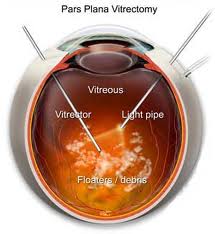
What is a vitrectomy?
Vitrectomy surgery is a form of surgery for the eye that treats disorders of the retina and vitreous.
The vitreous (gel within the main cavity of the eye) is removed with a miniature handheld cutting device and replaced with a special saline solution similar to the liquid being removed from the eye.
A vitrectomy may be combined with another surgical procedure, such as repairing a retinal detachment or removing a cataract.
Why is vitrectomy necessary?
A vitrectomy is required for a variety of conditions. These include:
● Retinal detachment
● Epiretinal membrane
● Macular hole
● Vitreous haemorrhage (blood in the main cavity of the eye)
● Diabetic retinopathy wth traction (bleeding and scar tissue formation)
● Proliferative vitreoretinopathy (severe scarring from retinal detachment)
● Endophthalmitis (severe infection inside the eye)
● Intraocular foreign body
● Complications from cataract surgery
What does vitrectomy involve?
A vitrectomy is performed in an operating theatre, usually under local anasthesia.
In a vitrectomy, the small gauge microsurgical instruments are placed into the eye through three tiny incisions in the sclera (the white part of the eye).
The vitreous gel is removed from the centre of the eye and is replaced by a special fluid similar to fluid naturally produced by cells inside the eye.
A self retaining cannula system is used to introduce various instruments into the eye. These instruments are used to remove the vitreous gel and any scar tissue that may be growing on the surface of the retina.
A laser probe can also be inserted into the eye so that laser can be performed during surgery.
At the end of surgery, the cannula system is withdrawn and the small incision sites self-seal without needing any stitches .
The benefits of sutureless surgery include minimal conjunctival (thin skin overlying the white of the eye) scarring, less post-operative inflammation and discomfort, quicker healing time and shorter operating time.
Vitrectomy surgery can take 30 minutes or longer depending on the
severity of the eye problem.
What are the potential risks?
Some of the risks of vitrectomy include:
- Formation of cataract (clouding of the natural lens in the eye). If you haven’t yet had cataract surgery, you will most likely need an operation within 2 years of the vitrectomy.
- Increase in eye pressure, causing glaucoma. This often requires treatment with eye drops to reduce the eye pressure. Sometimes, glaucoma surgery may be necessary to control the pressure.
- Retinal detachment
- Bleeding
- Infection
- Inflammation in other eye (exceedingly rare)
What can I expect?
Significant pain following surgery is not common. You may experience some discomfort and a scratchy sensation in the eye. This usually settles very quickly. If the eye becomes very painful, you must notify your surgeon immediately.
You will be discharged with an eye pad which needs to be removed the following day.
After the pad is removed, you will be required to use antibiotic and anti-inflammatory eye drops for 3 to 4 weeks.
If a gas bubble has been placed into your eye, be sure not to fly in an
aeroplane or climb high altitudes until the gas bubble has gone. A rapid
increase in altitude can cause a dangerous rise in eye pressure. Your vision will be poor until the gas is absorbed by the body.
If silicon oil has been placed into your eye, you will need a second operation to remove the oil from the eye. This usually occurs 6 to 12 weeks after the initial vitrectomy.
Visual improvement following vitrectomy surgery will depend on the
severity of your eye problem before surgery.
If your eye problem caused permanent damage to your retina before the vitrectomy, then improvement following surgery may not be significant.
Sometimes surgery is performed only to save the eye, rather than to
achieve an improvement in vision.


